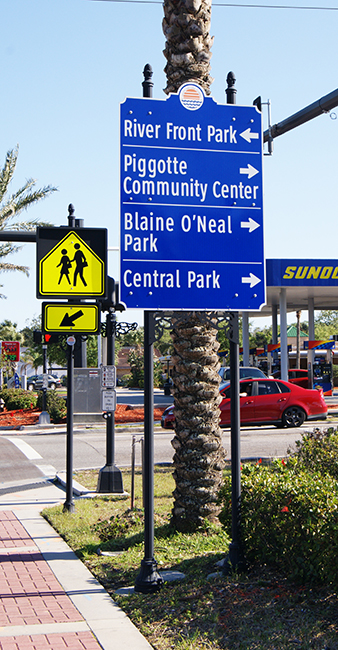What Is Pedestrian Wayfinding Signage?
Monday August 26, 2019Not all wayfinding signs are designed for motorists. Some are designed for pedestrians. Known as pedestrian wayfinding signage, it offers guidance for pedestrians, cyclists and other people who use a sidewalk or roadside area. Like conventional wayfinding signage, it contains information and/or directions that serve as guidance. The difference, however, is that pedestrian wayfinding signage is designed for pedestrians, whereas conventional wayfinding signage is designed for motorists. Because of this nuance, there are several things property developers must consider when installing and using pedestrian wayfinding signage.

Don't Use Retroreflective Signs
The Federal Highway Transportation Authority (FHWA) requires the use of a retroreflective surface for conventional street and traffic signs. Conversely, though, the FHWA's Manual on Uniform Traffic Control Devices (MUTCD) states that pedestrian wayfinding signs should not feature a retroreflective surface. If a wayfinding sign has a retroreflective surface, it will reflect back incoming light from vehicles' headlights. Since pedestrian wayfinding signs are intended for pedestrians, this can distract drivers and increase the risk of collision.
Face Towards Sidewalk or Roadside Area
When installing pedestrian wayfinding signs, face them towards the sidewalk or roadside area used by pedestrians. The direction in which a wayfinding sign faces may sound insignificant, but it can affect its utility as well as the safety of motorists in the area. When pedestrian wayfinding signs are faced towards a road, motorists may stop to read them. At the same, pedestrians may struggle to read the signs while walking on the sidewalk or roadside area. As a result, the FHWA recommends installing pedestrian wayfinding signs away from roads while also facing the signs towards the appropriate sidewalk or roadside area.
Use Smaller Legends
Pedestrian wayfinding signs should feature smaller legends than those of conventional wayfinding signs. By using smaller legends, motorists are less likely to read them. Most motorists will automatically recognize the sign as a pedestrian wayfinding sign if it features smaller legends than conventional wayfinding signs. Therefore, they won't take their eyes off their road to read the signs.
Consider Installing Over Sidewalks
The FHWA says that pedestrian wayfinding signs can be installed over a sidewalk, assuming it's mounted at a similar height as vehicle traffic signs. In other words, the pedestrian wayfinding sign must be cantilevered so that it hands over the sidewalk. Cantilevering isn't a particularly common method used to mount pedestrian wayfinding sign, but it's still allowed by the FHWA nonetheless.
About Forsite:
Welcome to Forsite! You’ve found your best source custom street signs and community wayfinding signs. We manufacture and install upscale site amenities throughout the United States.
Forsite can provide all of your signage needs for your Master Planned Community or Residential Development. We help our customers to create a uniform, upscale appearance and increase property values by "bundling" themed packages of decorative street signage, mailboxes, post and wall mounted lighting, and wayfinding signage
You can count on the experts at Forsite to help improve the quality of your community today. Contact us today to get started by talking to one of our experienced team members at 855-537-0200.


